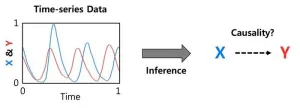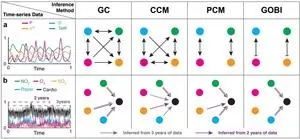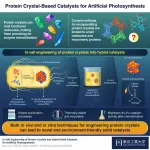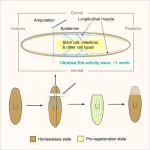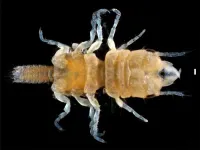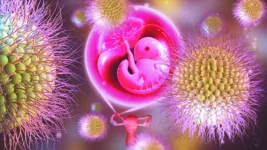(Press-News.org)
In the quest to unravel the underlying mechanisms of natural systems, accurately identifying causal interactions is of paramount importance. Leveraging the advancements in time-series data collection through cutting-edge technologies, computational methods have emerged as powerful tools for inferring causality. However, existing model-free methods have struggled to differentiate between generalized synchrony* and causality, leading to false predictions. On the other hand, model-based methods, while accurate, have been limited by their dependence on specific models, hindering their widespread applicability.
*Synchrony in time-series data refers to the occurrence of a consistent and simultaneous pattern. However, synchrony does not necessarily indicate a causal relationship. For example, changes in temperature and ocean tides both oscillate with a periodicity of one day, but they are unrelated.
Addressing these challenges head-on, a team of researchers from the Biomedical Mathematics Group within the Institute for Basic Science (IBS) has developed a groundbreaking computational package called General Ode Based Inference (GOBI). This innovative tool overcomes the limitations of both model-free and model-based inference methods by introducing an easily testable condition for a general monotonic ODE (Ordinary Differential Equation) model to reproduce time-series data.
Dr. KIM Jae Kyoung, the lead researcher behind GOBI, explains, “Our goal was to create an accurate and broadly applicable inference method that could unlock insights into complex dynamical systems. We recognized the limitations of existing approaches and set out to develop a solution that could overcome these challenges.”
GOBI goes beyond the capabilities of traditional model-free methods, such as Granger Causality, by successfully inferring positive and negative regulations in various networks at both the molecular and population levels. Unlike its predecessors, GOBI can distinguish between direct and indirect** causation, even in the presence of noisy time-series data.
** Indirect effect refers to the influence of one variable on another through intermediate variables. For example, the amount of grass indirectly affects the tiger population through the intermediary effect on the deer population, as grass serves as the food source for deer, and deer serve as the food source for tigers. The indirect effect does not necessarily indicate a causal relationship, as the amount of grass is not directly related to the tiger population.
PARK Seho, the 1st author of the paper, said “GOBI's strength lies in its ability to infer causal relationships in systems described by nearly any monotonic system with positive and negative regulations, as captured by the general monotonic ODE model. By eliminating the dependence on a specific model choice, GOBI significantly expands the scope of inference methods in complex systems.”
In addition to its powerful inferential capabilities, GOBI offers user-friendly features that simplify the computational process. The researchers have designed the package to be accessible to a wide range of users, including those without extensive computational expertise. Through GOBI, scientists and researchers can gain deeper insights into gene regulatory networks, ecological systems, and even understand the impact of air pollution on cardiovascular diseases.
The researchers have validated the effectiveness of GOBI by successfully inferring causal relationships from synchronous time-series data, where popular model-free methods have faltered. By providing accurate and reliable inference in a variety of scenarios, GOBI paves the way for a more comprehensive understanding of complex dynamical systems.
With its groundbreaking capabilities, GOBI promises to revolutionize the field of computational causal inference, empowering researchers to unlock the secrets hidden within complex systems. As the scientific community embraces this powerful tool, we can anticipate unprecedented advancements in various domains, including biology, ecology, and epidemiology.
Dr. Kim Jae Kyoung expressed excitement about the collaborative work with two exceptionally talented KAIST undergraduate students, PARK Seho and HA Seokmin, who have made great contributions to this study. As they embark on their new academic journey, PARK Seho will pursue graduate studies at the University of Wisconsin, Madison, while HA Seokmin will join the esteemed Massachusetts Institute of Technology (MIT) this fall.
END
In-cell engineering can be a powerful tool for synthesizing functional protein crystals with promising catalytic properties, show researchers at Tokyo Tech. Using genetically modified bacteria as an environmentally friendly synthesis platform, the researchers produced hybrid solid catalysts for artificial photosynthesis. These catalysts exhibit high activity, stability, and durability, highlighting the potential of the proposed innovative approach.
Protein crystals, like regular crystals, are well-ordered molecular structures with diverse properties and a huge potential for customization. They can assemble naturally from materials found within cells, which not only greatly reduces the synthesis ...
Can poor sleep and circadian rhythm make chronic pain conditions worse? Edson College Assistant Professor Chung Jung Mun plans to find out through an innovative longitudinal study.
Mun was awarded a $3 million grant from the National Institute of Neurological Disorders and Stroke, part of the U.S. National Institutes of Health, to explore the possible connection.
“There are countless individuals suffering from multiple chronic pain disorders. A person with chronic migraine headaches is also likely to suffer from chronic low back pain. What we’re trying to find ...
A Texas A&M University doctoral student has collaborated with an innovative surgical navigation and robotics company on motion capture research that can potentially improve implant alignment during knee replacement surgeries.
Aaron Henry is a fourth-year Ph.D. student in the Doctor of Philosophy in Interdisciplinary Engineering program in the Department of Multidisciplinary Engineering. He worked with Caira Surgical, a surgical navigation and robotic orthopedic surgery company that focuses on simplifying workflows and developing technological ...
A mouse injured on one leg experiences an “awakening” of stem cells in the other leg as if the cells are preparing to heal an injury. Something similar happens in axolotls, which are masters at limb regeneration. Heart injuries in zebrafish can trigger certain changes in far-away organs like the kidney and brain.
“In many different organisms, you can see the whole body respond to an injury. But whether or not those responses actually have any function has been unclear,” says Bo Wang, assistant professor of bioengineering at Stanford, “So that’s what we’re focusing on.”
In ...
Jakarta … San Francisco … Shanghai … Phoenix … Houston.
These major cities and others around the globe have many similarities, but they share one particular commonality that is concerning for residents. They are among the global cities most affected by climate change.
While each of these cities has proven resilient for centuries, urban planners, community leaders and civil engineers continue to address their many environmental challenges. In preparing for these cities’ future, however, it might be more ...
Most of the earthquakes rumbling under the West’s Great Basin come in surges, clustered together in time and place. Scientists call these seismic groups “swarms,” which are a distinct category from the numerous aftershocks following a big shake, such as the 5.7 magnitude Magna quake of 2020 on the Wasatch Fault.
Rather than getting spread out evenly over time, many of these small, often imperceptible quakes strike a region in a short period of time, say a few days or weeks.
Central Utah has been the stage for dozens of earthquake swarms that have been recorded over the past 40 years by an ever-expanding network of seismic arrays managed by the University ...
Encouraging Latinx adolescents of Mexican origin to embrace their ethnic pride, cultural values, and connections to their cultural community contributes to positive development and better adjustment during adolescence, a new University of California, Davis, psychology study suggests.
Moreover, researchers said, cultural preservation can help Latinx youth cope with adverse life experiences and social threats such as racism and discrimination.
The study results were published this month in ...
A Chapman University scientist and his colleagues have determined how the Earth responds as it heats up due to climate change.
The scientists say a warming world calls for a new approach in detecting how much carbon dioxide comes out of ecosystems when the temperature changes — which tells us how well plants and soil can alleviate damage by removing carbon pollution from the atmosphere. The study is the first to find the temperature-carbon dioxide release relationship at the landscape level.
Their ...
An international team of scientists from the University of Miami Rosenstiel School of Marine, Atmospheric, and Earth Science and the Water Research Group from the Unit for Environmental Sciences and Management at the North-West University in South Africa have discovered a new species of marine cryptofauna in the Florida Keys. Cryptofauna are the tiny, hidden, organisms that make up the majority of biodiversity in the ocean.
The roughly three-millimeter-long isopod is one of only 15 species from the genus Gnathia currently known in the region.
The newly discovered species, Gnathia jimmybuffetti, which is a member of a group of crustaceans called gnathiid isopods, were collected ...
PORTLAND, Ore. – Researchers in the Oregon State University College of Pharmacy have developed a drug delivery system that shows promise for greatly enhancing the efficacy of the medicine given to women with the life-threatening condition of ectopic pregnancy, which occurs when a fertilized egg implants somewhere other than the lining of the uterus.
Olena Taratula of the OSU College of Pharmacy, and Maureen Baldwin and Leslie Myatt of Oregon Health & Science University led a team that used a mouse model to show ...
